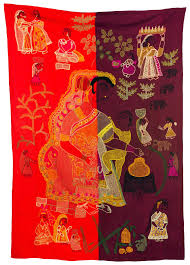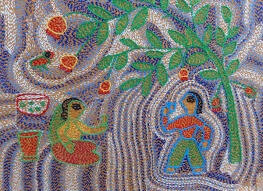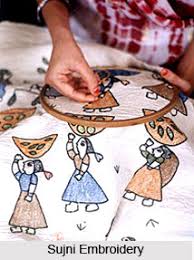Every region in India has its own rich culture, its distinctive embroidery symbolizing its unique ethnic essence of traditions. Delicately or densely patterned, with muted or vibrant shades, these designs have universal appeal. India has being famous for its textile and ethnicity in clothing since long time.
Today we see one of the most aesthetic designs which comes from Bihar, Sujani is one of the age-old embroideries. Sujani is one of the conventional forms of art in Bihar. This art has been preserved by the ladies of the rural villages of Bihar where this art form is studied. Women create this craft in their free time in their houses.
Sujani we bring empowerment
They made a traditional quilt for household use which became quite famous. The craftswomen produce furnishings such as bedspreads, wall hangings, cushion and bolster covers, as well as clothing items like saris, dupattas, and kurtas. Sujani is created with simple stitches, sometimes with readily available fabrics and occasionally with well-worn clothes, craftswomen generally practice this craft in their free time.
Traditionally, when a child was born, a quilt made with stitching different pieces of sarees and dhotis; these are then stacked in piles of four to five and sewn together with a simple running stitch, the purpose of this quilt is to make baby feel his mother’s presence.
The old cloth was used to represent the soft and warm resemblance of mother. In fact, the word Sujani itself reflects this principle – ‘su’ means easy and facilitating, while ‘jani’ means birth. Sujani served a ritual function – it invoked the presence of a deity, Chitiriya Ma, the Lady of the Tatters and stitching together these disparate pieces symbolically embodied the holistic Indian concept that all parts belong to the whole and must return to it.
Sujani has remarkably shifted from its traditional craft to a channel for expressing contemporary social and political issues. Social change has been the purpose and essence of revival of this project. The embroidery collectively voices the injustice and tragedy women face in everyday life- drunk, disabled, absentee or unemployed husbands, unsympathetic and cruel mother-in-law, dowry burning, female infanticide, rape, property that has been mortgage to pay off debts.
A typical quilt is divided into two parts. One side seeks to portray the realities-a drunken man beating his wife; a man giving dowry; men cloistered in a village meeting, and women in purdah.
The other side seeks to express a vision – a woman selling her produce in the market; a woman addressing a meeting; a woman judge, and power! Sun and cloud motifs signifying life-giving forces, fertility symbols, sacred animals, fantastic winged creatures for protection against destructive forces, and other motifs to attract blessings from the gods. Different coloured threads were also symbolically used, such as red, signifying blood, a life force, and yellow for the sun.
MVSS, or Mahila Vikas Sahiyog Samiti, is a small autonomous society which is based in Bhusuda. The community works for the revival and art of Sujani. The organization also provides financial assistance to the women working in this art. Located 30 kilometers away from Muzzafarpur station, Bhusuda is a place of origin of Sujani. Many small craft clusters are spread around Bhusuda village, namely- Bhaghakhal, Hasna, Ramnagar, Durganagar, Dahiya, Kotiya, Chidaila and Jarang where this art form is practiced.
Technique:
At present, raw material, which is used as a base fabric for Sujani, is usually made of cotton, locally known as “salita cotton” which is a coarse cotton fabric (count 44/50). Embroidery threads are procured from Muzzafarpur market. Usually Anchor or Dolly embroidery threads are used.
Few tools required for making the end product are sewing needles (No. 9/10), embroidery frame, scissors, pencil markers, chalk powder, tracing paper etc. The designs are transferred onto the fabric by drawing it directly onto cloth with pencil marker or are traced using tracing paper and pores are made with needles.
It is transferred onto the desired fabric by placing the tracing sheet and rubbing a thick mixture of blue chalk powder with kerosene onto the tracing paper. The pores in the tracing sheet absorb the chalk powder resulting into the creation of outline of the designs onto the fabric.
The background is filled with the fine running stitch with thread whose colour is similar to the background. It gives a wavy effect. Chain stitch usually in black, brown and red thread is done for the main outline of the motif and the design is then filled with running stitch in coloured threads. Sujani is labour intensive; the number of stitches per square inch varies from 105-210.
Problems faced by Sujani artisans are lack of education, lack of fund and problems due to regular floods. Initially MVSS was started with approximately two thousand women embroiderers. But later this reduced to around 250 women embroiders due to lack of market demand. Recent buyers include few entrepreneurs and fashion designers specializing in traditional embroideries.
Sujani has emboldened women who have been living in poverty and are not allowed to work in society. Women now bring in money in their families and their work is one practiced by their male family members and is deemed ‘respectable’.
Sujani is expensive in markets because of its time consuming factor, intricacy and hard work. However, if we explore more on the different techniques of embroidery to make it more commercially available, we can help retaining the age old tradition of Bihar. Sujani craft has all the potential to create its impact and can become commercially accessible too if it is explored more towards the use of techniques and designs by retaining its natural charm.






